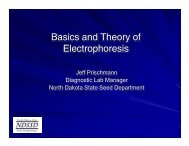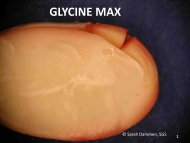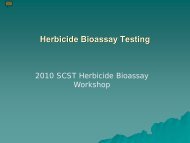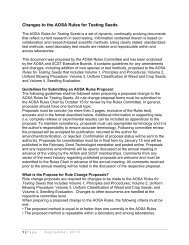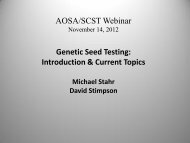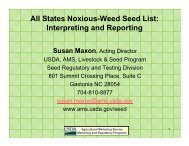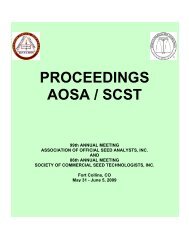Lateral Flow Strip Function and Utility
Lateral Flow Strip Function and Utility
Lateral Flow Strip Function and Utility
Create successful ePaper yourself
Turn your PDF publications into a flip-book with our unique Google optimized e-Paper software.
<strong>Lateral</strong> <strong>Flow</strong> <strong>Strip</strong> <strong>Function</strong><br />
<strong>and</strong> <strong>Utility</strong><br />
© EnviroLogix 2006
<strong>Lateral</strong> <strong>Flow</strong> Test – Markets<br />
Served<br />
• Medical – Rapid point of care testing<br />
• Agriculture – GMO’s <strong>and</strong> mycotoxins<br />
• Environmental – Pesticide testing<br />
• Veterinary – Blood borne diseases<br />
• Water Quality – Algal toxin testing<br />
• Advantages: High sensitivity, highly reliable, simple<br />
to use, inexpensive, <strong>and</strong> excellent for on-site testing.<br />
© EnviroLogix 2006
<strong>Lateral</strong> <strong>Flow</strong> Test Development<br />
• Antibody development<br />
• Selection of nitrocellulose<br />
• Development of appropriate on-board buffer<br />
• Evaluation of test sensitivity <strong>and</strong> specificity<br />
• Scale up of product<br />
• Internal <strong>and</strong> external validation<br />
• Each lot must meet strict release<br />
specifications<br />
© EnviroLogix 2006
<strong>Lateral</strong> <strong>Flow</strong> Test Production<br />
• Definition<br />
Reel to reel application of capture <strong>and</strong> control<br />
antibodies at predetermined titers to<br />
nitrocellulose membrane. Proteins bind<br />
electrostatically to nitrocellulose through<br />
interaction of the strong dipole of the nitrate<br />
ester with the strong dipole of the peptide<br />
bonds.<br />
• Typical Batch<br />
• 2 Rolls…100 M…25000 Devices<br />
• 2 Days to complete<br />
− One day to spray<br />
− Dry overnight<br />
− Mount onto polystyrene backing<br />
© EnviroLogix 2006
<strong>Lateral</strong> <strong>Flow</strong> Test Gold Conjugate<br />
Production<br />
• Definition<br />
Evaluation of several levels of pilot sprayed gold<br />
conjugate to optimize batch for sensitivity (intensity)<br />
vs. specificity (NSB) across a relevant assay range.<br />
Reel to reel application of the optimal level of gold<br />
conjugate passively onto treated conjugate pad.<br />
• Typical Batch<br />
• Titration - 1 to 2 days<br />
• Spraying<br />
− One day to spray<br />
− Dry overnight<br />
− Begin assembly<br />
© EnviroLogix 2006
<strong>Lateral</strong> <strong>Flow</strong> Test Formats<br />
• S<strong>and</strong>wich Assay<br />
• Antigen is captured between two antibodies.<br />
• Excellent for larger molecules (ex. Proteins with a<br />
M.W. typically >10,000).<br />
• Two lines is positive (the darker the test line usually<br />
the more antigen present).<br />
• Competitive Inhibition Assay<br />
• Used to test for small molecules that are unable to<br />
be used in a s<strong>and</strong>wich assay (agrochemicals <strong>and</strong><br />
environmental pollutants with a M.W.
Examples of <strong>Lateral</strong> <strong>Flow</strong> Test<br />
Formats<br />
• S<strong>and</strong>wich Assay – Animated LFD Demo<br />
• Competitive Inhibition Assay<br />
• Example: Test for Aflatoxin<br />
•<br />
− BSA-aflatoxin is sprayed on the test line.<br />
− <strong>Strip</strong> tailpad has antibodies conjugated to a gold particle that<br />
will bind to aflatoxin.<br />
− When no aflatoxin is present in the sample the antibody-gold<br />
conjugate migrates up the strip <strong>and</strong> binds to aflatoxin sprayed<br />
on the test line <strong>and</strong> a test line develops.<br />
− When aflatoxin is present in the sample it will bind to the<br />
antigen binding sites of the antibody making it unavailable to<br />
bind to the aflatoxin sprayed down on the test line (no test line<br />
develops).<br />
© EnviroLogix 2006
<strong>Lateral</strong> <strong>Flow</strong> Test Markets:<br />
Bulk Grain<br />
− Corn <strong>and</strong> soy arrive at an “elevator” where the<br />
crop is graded (moisture, damage, seed weight,<br />
foreign material) <strong>and</strong> tested for GMO<br />
contamination if load is being delivered as non-<br />
GMO.<br />
− Several probes of the crop are removed from the<br />
truck for analysis.<br />
− Fast tests are essential. Crops are segregated based<br />
on test results.<br />
− Farmers receive different prices based on crop<br />
quality.<br />
− Barges or trains are loaded to transport the crops<br />
around the world or within the U.S.<br />
− Grain transporting vehicles are large 18 wheel<br />
trucks. Over 200 may be lined up during harvest<br />
to have their load weighed <strong>and</strong> tested.<br />
© EnviroLogix 2006
Preparing Bulk Grain Samples<br />
• Achieving a proper grind is vital<br />
• A finer grind results in better protein extraction <strong>and</strong> better sensitivity.<br />
Too fine a grind could result in poor sample flow up the strips. Ground<br />
corn should be the consistency of coffee grounds.<br />
• Bunn coffee grinders (set to Fine) are excellent for bulk sample<br />
processing. Waring blenders are laboratory grade blenders for sample<br />
processing.<br />
© EnviroLogix 2006
Extraction of Bulk Grain Samples<br />
• Sample Extraction<br />
• Measure <strong>and</strong> add water<br />
− Too much volume will dilute sample. Too little volume could cause<br />
flow problems.<br />
• Mix well<br />
− Make sure that all of the corn is wetted. Shake for 30 seconds.<br />
© EnviroLogix 2006
Removal of Extract from Bulk<br />
Grain Samples<br />
• Allow sample to settle. Draw up extract <strong>and</strong> place in a<br />
reaction vial or comb cup. Try to transfer as few corn<br />
particles as possible.<br />
Liquid<br />
Solids<br />
© EnviroLogix 2006
Testing & Interpretation of Bulk<br />
Grain Samples<br />
• Insert QuickStix strip or comb arrows<br />
pointing down.<br />
© EnviroLogix 2006
Testing Interpretation<br />
• Wait 5 Minutes<br />
• Read <strong>and</strong> retain results<br />
© EnviroLogix 2006
Interpretation of <strong>Lateral</strong> <strong>Flow</strong><br />
Tests with a <strong>Strip</strong> Reader<br />
• Semi-quantitative testing of GMO<br />
content in bulk grain samples.<br />
• Ranges:<br />
• 0.0-0.25%<br />
• 0.25-1.0%<br />
• 1.0-3.0%<br />
• 3.0-5.0%<br />
• >5.0%<br />
© EnviroLogix 2006
<strong>Lateral</strong> <strong>Flow</strong> Markets:<br />
Single Seed Testing<br />
• Seed producers concerned with seed purity will use<br />
lateral flow tests to evaluate GMO content.<br />
• <strong>Strip</strong>s can test up to three events on the same strip<br />
(Ex. LL, Cry1Ac, Cry2a).<br />
• Seeds can be crushed individually in a tube or in a<br />
48-well plate with a seed crusher.<br />
© EnviroLogix 2006
<strong>Lateral</strong> <strong>Flow</strong> Markets:<br />
Leaf Tissue Testing<br />
• Used in plant breeding (is the plant<br />
expressing the correct proteins?)<br />
• Plant pathogen testing (soybean rust)<br />
• In-field testing (is this where I planted the RR<br />
corn?)<br />
© EnviroLogix 2006
<strong>Lateral</strong> <strong>Flow</strong> Markets:<br />
Mycotoxins<br />
• Toxins are too small to be<br />
used in a s<strong>and</strong>wich<br />
immunoassay. Use a<br />
competitive inhibition assay<br />
for testing.<br />
• Examples: DON, Aflatoxin,<br />
• Toxin testing may require<br />
finer grinds <strong>and</strong> alternative<br />
extraction solutions<br />
© EnviroLogix 2006
Mycotoxin Competitive<br />
Inhibition Assay<br />
© EnviroLogix 2006
Troubleshooting<br />
• Common errors<br />
• Background color<br />
− The strip was left in the liquid too long<br />
• Liquid does not travel up the strip<br />
− The strip was bent or grabbed in the middle,<br />
membrane damaged<br />
− Clogged sample pad, sample is ground too fine<br />
− Improper amount of extract in vial or incorrect<br />
vial<br />
• No Control Line<br />
− Oops, upside down strip, arrows are facing up<br />
− <strong>Strip</strong>s are expired, check date on package<br />
− Improper amount of extract in vial<br />
• False Negatives<br />
− Didn’t allow strips to reach room temperature,<br />
or strips placed in very hot vehicle or window<br />
© EnviroLogix 2006
Test <strong>Strip</strong><br />
• Kit Storage<br />
• Room temperature stable<br />
• For longer shelf life or very<br />
hot conditions, store strips<br />
refrigerated<br />
• Avoid direct heat<br />
• Kit Use<br />
• If refrigerated, bring to room<br />
temp before opening canister<br />
• H<strong>and</strong>le Carefully<br />
• Avoid touching or crimping<br />
the membrane, the sample<br />
needs to flow. The antibodies<br />
are coated here as well.<br />
© EnviroLogix 2006



